'A Ghost Story' Director on Casey Affleck's Sheet, Rooney Mara's Pie Binge (P.S. It's OK to Laugh)
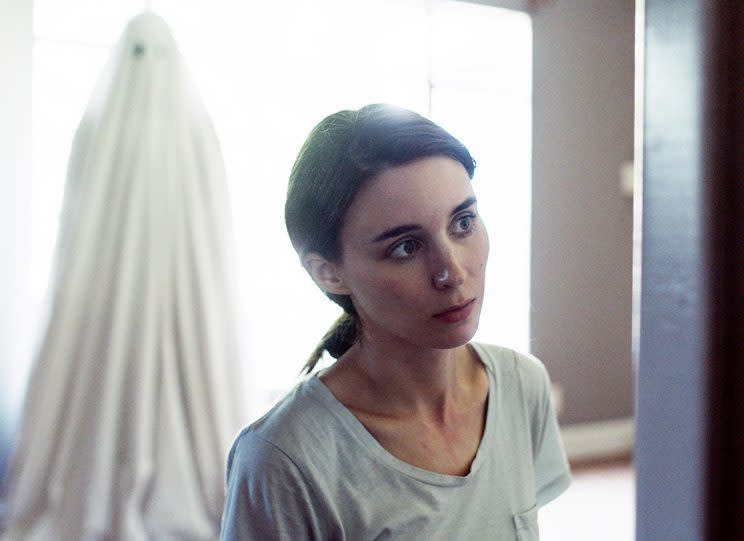
David Lowery is very good at keeping secrets. Even as he was putting the finishing touches on his first big-budget film, Pete’s Dragon — an updated version of Disney’s 1977 live-action/animated musical — last summer, he was in the midst of making his follow-up feature, A Ghost Story, far off the Hollywood radar. It remained hush-hush even though it starred two high-profile actors, Rooney Mara and Oscar winner Casey Affleck, who had previously appeared together in Lowery’s 2013 breakthrough, Ain’t Them Bodies Saints. When Yahoo Movies spoke with Lowery last August, we specifically asked whether he considered casting Will Oldham — one of the musicians featured on the Pete’s Dragon soundtrack — in the film itself. He managed to answer our question without spoiling that Oldham has a scene, a pretty memorable one, in A Ghost Story. “We had basically just finished shooting this at that point,” the director says now. “We all had on a pretty strong poker face for this movie.”
Lowery didn’t play his hand, so to speak, until A Ghost Story was announced as part of the lineup for the 2017 Sundance Film Festival. On the ground in Park City, the film immediately sparked passionate pro and con debates. (For the record, it was one of our festival favorites.) Those arguments will likely continue now that the film is haunting movie screens, having opened in limited release on July 7, with its spectral presence expanding to more screens as the summer continues. Lowery’s deliberately spare script follows a musician (Affleck) who dies in a traffic accident, leaving behind his grieving lover (Mara). Rather than pass onto the next world, his spirit returns to the house they shared to linger there for years… and possibly centuries. We spoke with Lowery about creating a sense of “living history” in the film, what freaks him out (empty apartment buildings), and why it’s OK with him if viewers laugh — or walk out — during A Ghost Story.
Yahoo Movies: Let’s start with the Will Oldham scene, where he delivers an extended speech that’s easily the longest bit of dialogue in the film. How did you decide he’d be the one to say those words?
David Lowery: I would love to have Will Oldham involved with any of my films, because I admire and respect him so much and love his voice, both as a musician and also just as a human being. We had made a short film together called Pioneer, in which he tells a 15-minute bedtime story to a little boy, and that’s all the movie is. I knew then that he would be able to hold the screen and deliver a monologue essentially for that period of time. As a singer-songwriter, he is intrinsically a storyteller and knows how to find the common ground between storytelling and performing. So when we were getting ready to put this movie into motion and had this eight-page monologue at the two-thirds mark, he was the first person I thought of for it. I sent him the script and thankfully he was into it and wanted to do it. So, yeah, this is the third time we’ve collaborated, and I hope we keep finding projects to work on regardless of whether they have long monologues. Maybe next time he could do an all-silent cameo in the background.
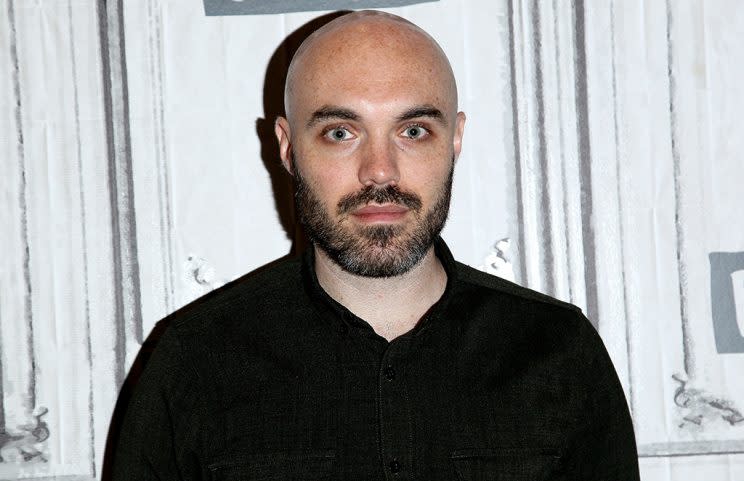
I recently moved into a new home, and often find myself thinking about its history and the people that might have lived there before, and that idea is certainly central to A Ghost Story. Do you know or often think about the history of your own home?
My wife and I are about to move, and just the other night she was online looking through historical records trying to find out if anyone had died in the house, because that’s one of the things that she cares about knowing when she moves. She’s always very concerned with bad energy, as am I, but I don’t think dying in a house necessarily will leave bad energy. I think it can sometimes leave very good energy; it means that someone loved it enough to stay there their entire life. I’m not a spiritual person myself; I define myself as an atheist, and yet I feel like there’s a connection that’s not purely just academic. I feel like there is something there, whether an energy or a presence, or who knows what. I don’t think it necessarily has to be supernatural.
So that is something I think about. I want to know the history of the spaces that I’m in; I like looking at photos of cities that I know very well in their infancy. You know, you can find those books of old pictures of New York or Los Angeles, or in my case Dallas, and just see where those streets first began and these ghostly black-and-white images of people walking up and down avenues that you now drive up and down on a daily basis. That’s a beautiful and mysterious and important thing to me, and I like being connected to that. It’s been there in all of my movies so far, never to the degree that it is in this one. It’s something that I’m sure I’ll keep returning to.
The timeline of A Ghost Story travels months, years, and even centuries into the future, but there’s also a timeless feeling to the film. Except in a few instances, you’re never sure what year you’re actually in.
I live in Dallas, where old houses are getting knocked down all the time and turned into condos. If you don’t live in a house that’s historically preserved in this day and age, I feel like it’s very prone to demolition and redevelopment as a skyscraper. That’s just the way our society works at this point. In the movie, we spend an hour in this house, and I was fascinated by the idea of that space transforming and mutating. I wanted to tap into that a little bit, not in a sociological way, but just as a representation of what the history of a space is going to look like as we move forward.
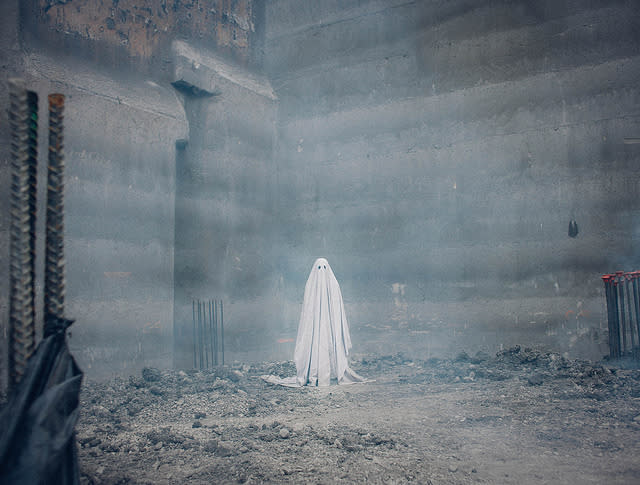
Urban development is a big signifier of that. The fact that this rustic house all of a sudden becomes a gaping pit in the Earth is a tremendous signifier of change. And then that pit transforms into a tower, and the tower gradually gets walls and offices. That transition from something that was domestic into something corporate is another big signifier of the passage of time. And then, of course, the ending of the sequence when you arrive at the top of the building that’s been erected and find that this relatively rural neighborhood that you once knew has become a teeming cityscape that looks like it’s something out of Blade Runner.
When you think about it in practical terms, a skyscraper takes two to five years to be erected and completed. But when you see all the development that’s occurred around it, you realize that a lot of time has gone by. And while we don’t put a number on it, it’s meant to be significant. We also put a flying car deep in the background to really hint that this is a representation of a world that has greatly transformed.
Your films do tend to take place in rural or small town settings, and it’s notable that the cityscape we see at the end of this one is foreboding. Are you expressing your own ambivalence about urbanization and what it means?
A little bit. I don’t live in the countryside; I live in a nice neighborhood that feels like a neighborhood you’d want to raise a family in. But it’s by no means rural whatsoever. At the same time, I find creative value in the images of rural living, and the idea of a homestead is one that resounds very strongly with me. I think there’s probably something in having grown up reading Little House on the Prairie; the idea of staking out your own home for your family and establishing it. I don’t know if it’s foreboding, but the movie definitely makes the high-rise feel terrifying. I don’t necessarily share that feeling but there is something about it that leads me in the direction of making it a bad thing.
I do get a little stressed out when I see skylines overrun with condo buildings. I have nothing against condos, you know, they’re beautiful and if they suit you that’s great. But there’s just so many of them, and it really freaks me out a little bit. Who’s going to live in all those spaces? What’s going to happen to them? They just feel like they’re already empty. It’s not really relevant to this movie, but it’s something I spend a lot of time thinking about.
It is relevant to the film in the sense that those spaces might not ever be inhabited by a person or family. As a result, they won’t come to accumulate a sense of history or, for that matter, ghosts.
I’ve read articles about how a lot of the buildings in New York are designed not to have maximum occupancy. They don’t need maximum occupancy to succeed. They can just remain empty and satisfy the investors who contributed to their construction. You barely hear this, but in the movie when the ghost is wandering around the boardroom [in the office building where his home used to be] the guy at the table is delivering a monologue about how the building can remain empty and still be successful. That’s pulled directly from those articles I’d been reading about buildings going up that don’t need residents.
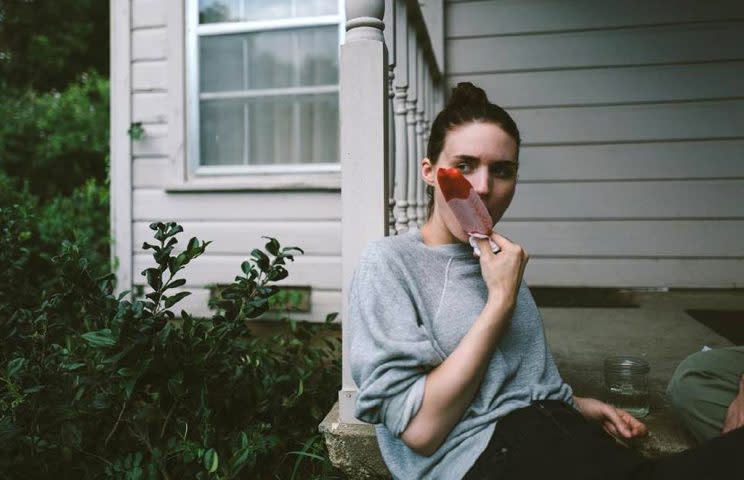
I should ask about Rooney Mara’s extended pie-eating scene, which has been causing quite a stir. Did you intend for that scene to be a test for the audience in a sense?
It wasn’t meant to be a litmus test, but I knew that it would probably function as that. It also wasn’t meant to be a meme, but I also know that it would probably become one. It’s a really personal scene, and a very intimate scene, that it’s impossible not to talk about it. And I completely embrace that. We knew that the scene, if it worked, was going to be a scene that people would talk about. At the same time, I knew that if it worked, all of the anticipation that people would have going into it would be waiting for the pie scene to happen. Hopefully, two minutes into it, when people realize it’s still going on, the anticipation just evaporates and you just exist in that scene the way it was intended to function.
I also definitely expected people to walk during it! It comes 20 or 25 minutes into the movie, and it’s the longest shot in the movie. There’s nothing else that holds for that length of time, and it is an opportunity for audiences to decide if they’re with the movie. If they want to bail, that’s a great time to leave! [Laughs] But if they go with it and just accept it on its own terms, I think it opens all sorts of doors into how you can experience this movie and how you can experience cinema as a whole. I hope people stick with it, because I think the benefits that it reaps are substantial.
It’s also a moment — along with a few others in the film — that inspired some laughter in the audience I saw the film with. Are you prepared for that reaction?
Oh sure. To be 100 percent honest, the image of the ghost in the sheet was one that I became fixated on because it made me laugh. The idea of seeing that ghost in an empty house was funny to me, but it also was very sad. It was an image that contained multitudes, to use the oft-used cliché. I wanted this movie to function on that level. I wanted it to be OK for people to laugh at it, because it is goofy and at the same time there’s more to it than that. It doesn’t end at the goofiness. If we succeed, and I think we have, people will laugh.
The first time he sits up in that hospital, the first time he walks down that hallway and you see his eyes, it is 100 percent OK to chuckle or to laugh. And when he sees the ghost next door and they wave at each other, you’re supposed to laugh at that. But the laughter doesn’t define the moment. It’s just your entryway. Once you laugh, you’ve opened yourself up to other emotions. You become emotionally exposed, and hopefully that exposure gives way to wonder or sadness, anger or fear and something ultimately more bittersweet and elegiac. But laughter is the gateway to it and to me making this movie, because I did think that it was just a funny idea.
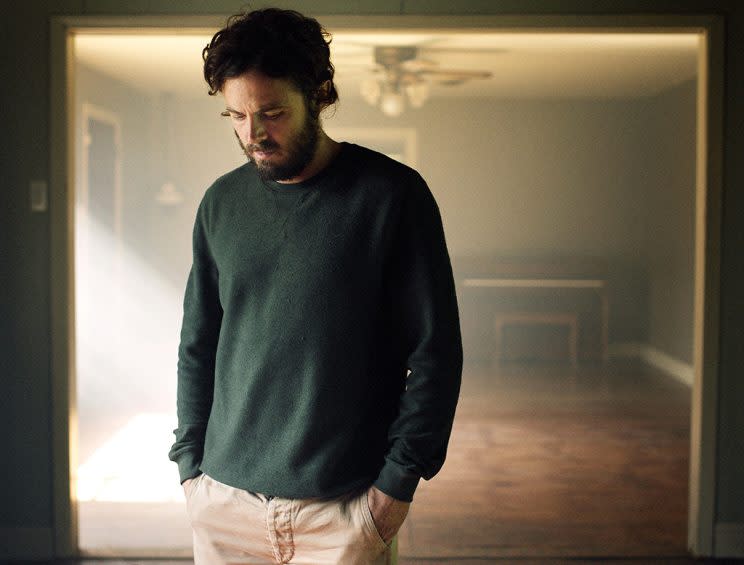
I’ve read that you’ve made some of your early short films unavailable. What was the motivation behind that?
I was still learning how to make movies, and I don’t think there’s that much value to them. I understand the curiosity level might be increasing and people might want to see them, but as someone who has made them and seen them, I can attest to the fact that there’s not much there. I was still figuring out what I was doing — and I’m still figuring out what I was doing — but at that stage they’re just home movies basically.
I made this movie called Lullaby right out of high school, and it was a great learning experience. I met a lot of my collaborators that I still make movies with, but it’s not a movie that’s worth watching. There’s a reason no one has ever seen it. I submitted it for Sundance, I submitted it to South By Southwest, and it didn’t play there for a very good reason. And it’s that for same reason I’m not making them publicly available. Also, they only exist on VHS and I don’t even have VCR. So I have no way to show them or get them online!
One of the most famous examples of a filmmaker making his earliest work unavailable is Stanley Kubrick, who tried to suppress his first feature, Fear and Desire, during his lifetime. That movie is now commercially available to buy or stream, and I do wonder how he’d feel about that if he were still alive.
I haven’t seen Fear and Desire, but I know where he’s coming from. There are things in my first feature [2009’s St. Nick] that I feel are embarrassing or amateurish, but I’m still very proud of that movie. I feel it’s up to the filmmaker; if, after I die, something I don’t want to be seen is exhumed and shown, that’s fine. I’m not going to be around to see it.
So you won’t be a ghost in a sheet haunting a theater where the audiences are watching Lullaby?
No, that sounds like a nightmare. I hope not! [Laughs]
‘A Ghost Story’: Watch the trailer:
Read more from Yahoo Movies:


